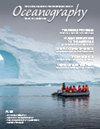使用BioCam可视化多公顷海底栖息地
IF 2.8
4区 地球科学
Q1 OCEANOGRAPHY
引用次数: 6
摘要
绘制海底地图时。这一点很重要,因为我们选择收集的数据类型从根本上改变了可以遵循的科学。配备相机的自动水下航行器(AUV)拍摄的照片代表了距离/分辨率权衡的一个极端,在这种情况下,可以达到亚厘米的分辨率,但通常只能在2米至3米的近距离拍摄。首先,在每张图像中都可以观察到更大的足迹,其次,在更高的高度操作时,与崎岖地形碰撞的风险较低,这允许使用飞行型AUV(例如,图1中所示的Autosub6000),它比通常用于视觉调查的悬停型AUV更快、更节能。综合这些因素,可以在一次AUV部署中绘制几十到一百多公顷的海底地图。BioCam是一种高空三维(3D)成像系统,使用一对高动态科学互补金属氧化物半导体(sCMOS)相机,每个相机的分辨率为2560×2160像素,安装在4000米额定钛外壳中。外壳有圆顶窗,可最大限度地减少图像失真,还包括用于通信、数据存储和控制BioCam用于获取3D图像的双LED频闪和双线激光器的低功耗电子设备。LED频闪每个发出200000流明的暖色调白光,持续4毫秒。每个激光器将一条绿线(525 nm,1 W 4级)投射到海底,与AUV的行进方向成直角,以测量地形形状。光学组件沿AUV底部排列,每个LED和激光器安装在相机的前部和后部(图1)。这些照明源和相机之间的大距离确保了高质量的图像,并且可以从6米到10米的目标高度收集高分辨率测深数据。sCMOS相机的大动态范围对于高空成像是必要的,因为红光在水中的衰减比绿光和蓝光强得多(图2)。大的动态范围允许以足够的位分辨率检测低强度红光以恢复颜色信息,同时检测其他颜色通道的更强烈的光而不饱和。双激光器的距离信息允许计算光从频闪到每个检测像素的传播距离,以进行精确的颜色校正(见图2)。将校正后的颜色投影到激光点云上,并与AUV导航数据融合,以生成纹理重映射的3D视觉重建(Bodenmann等人,2017)。BioCam处理管道校准双激光设置,以便在不需要人工现场校准目标的情况下,可以进行长度、面积和体积的定量测量以及尺寸不确定性的估计(Leat等人,2018)。尽管三维重建对于研究详细的海底信息很有用,但探索它们既耗时又主观。为了帮助在研究探险期间计划更有效的数据采集,能够在探险相关的时间框架内快速了解大型地理参考图像数据集是很有价值的。为此,我们开发了位置引导的无监督学习方法(Yamada et al.,2021),该方法可以使用BioCam自动学习地理参考可视化多公顷海底栖息地中最能描述图像的特征本文章由计算机程序翻译,如有差异,请以英文原文为准。
Visualizing Multi-Hectare Seafloor Habitats with BioCam
when mapping the seafloor. And it is important because the type of data we choose to collect fundamentally changes the science that can follow. Photos taken by cameraequipped autonomous underwater vehicles (AUVs) represent one extreme of the range/resolution trade-off, where sub-centimeter resolutions can be achieved, but typically only from close ranges of 2 m to 3 m. Taking images from higher altitudes increases the area mapped during visual surveys in two ways. First, a larger footprint can be observed in each image, and second, the lower risk of collision with rugged terrains when operating at higher altitudes allows use of flight-style AUVs (e.g., Autosub6000 shown in Figure 1), which are faster and more energy efficient than the hover-capable vehicles typically used for visual surveys. Combined, these factors permit several tens to more than a hundred hectares of the seafloor to be mapped in a single AUV deployment. BioCam is a high-altitude three-dimensional (3D) imaging system that uses a stereo pair of highdynamicrange scientific complementary metaloxide semiconductor (sCMOS) cameras, each with 2,560 × 2,160 pixel resolution, that are mounted in a 4,000 m rated titanium housing. The housing has domed windows to minimize image distortion and also includes low-power electronics for communication, data storage, and control of the dual LED strobes and dual line lasers BioCam uses to acquire 3D imagery. The LED strobes each emit 200,000 lumens of warm hue white light for 4 milli seconds. The lasers each project a green line (525 nm, 1 W Class 4) onto the seafloor at right angles to the AUV’s direction of travel to measure the shape of the terrain. The optical components are arranged along the bottom of the AUV, with an LED and a laser each mounted fore and aft of the cameras (Figure 1). A large distance between these illumination sources and the cameras ensures high-quality images, and high-resolution bathymetry data can be gathered from target altitudes of 6 m to 10 m. The large dynamic range of the sCMOS cameras is necessary for high-altitude imaging because red light attenuates much more strongly than green and blue light in water (Figure 2). A large dynamic range allows detection of low intensity red light with sufficient bit resolution to restore color information, while simultaneously detecting the more intense light of the other color channels without saturation. Range information from the dual lasers allows the distance light travels from the strobes to each detected pixel to be calculated for accurate color rectification (see Figure 2). Rectified color is projected onto the laser point cloud and fused with AUV navigation data to generate texturemapped, 3D visual reconstructions (Bodenmann et al., 2017). The BioCam processing pipeline calibrates the dual laser setup so that quantitative length, area, and volumetric measurements can be made together with estimates of dimensional uncertainty, without the need for artificial field calibration targets (Leat et al., 2018). Although 3D reconstructions are useful for studying detailed seafloor information, exploring them is both time-consuming and subjective. To help plan more effective data acquisition during research expeditions, it is valuable to be able to rapidly understand large georeferenced image data sets in expedition-relevant timeframes. For this, we have developed location-guided unsupervised learning methods (Yamada et al., 2021) that can automatically learn the features that best describe images in a georeferenced Visualizing Multi-Hectare Seafloor Habitats with BioCam
求助全文
通过发布文献求助,成功后即可免费获取论文全文。
去求助
来源期刊

Oceanography
地学-海洋学
CiteScore
6.10
自引率
3.60%
发文量
39
审稿时长
6-12 weeks
期刊介绍:
First published in July 1988, Oceanography is the official magazine of The Oceanography Society. It contains peer-reviewed articles that chronicle all aspects of ocean science and its applications. In addition, Oceanography solicits and publishes news and information, meeting reports, hands-on laboratory exercises, career profiles, book reviews, and shorter, editor-reviewed articles that address public policy and education and how they are affected by science and technology. We encourage submission of short papers to the Breaking Waves section that describe novel approaches to multidisciplinary problems in ocean science.
 求助内容:
求助内容: 应助结果提醒方式:
应助结果提醒方式:


